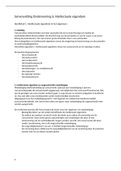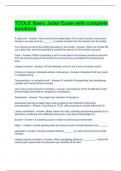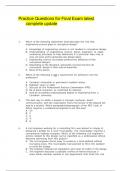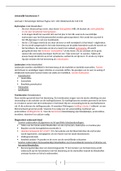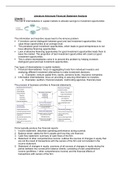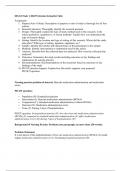Summary Organization and Environment
Lecture 1 (11-04-23)
Introduction lecture
What is strategy?
- Strategy formation is done by visionaries
- Strategy is formed by humans: biases in strategic decision-making
- Strategy is formed by whoever is the strongest politically
- Strategy is formed by imitating what other firms do
Theoretical perspectives to be discussed in this course:
Prescriptive:
- Design school
- Planning school
- Positioning school
Descriptive:
- Entrepreneurial
- Cognitive
- Learning
- Power
- Cultural
- Environmental
- Configurational
Lecture 2 (14-04-23)
The Design School
What is strategy?
- Plan: consciously intended direction, guide, or course of action to move from a
present state to a future state
- Ploy: a manoeuvre to outwit an opponent
- Pattern: recognizable similar actions that emerge over time
- Position: the organization’s location in the imaginary landscape of the
competitive environment
- Perspective: the interpretation of managers of the organization and its
environment
Characteristics and premises of Design School:
- Strategy formation as a deliberate process of conscious thought
- One person develops strategy: CEO
- Process of strategy formation should be simple and informal
- Design strategies should be one of a kind
- Strategy developed to attain match or fit between internal capabilities and
external possibilities (SWOT analysis)
- The strategy design process is complete when strategy appears fully
formulated as a perspective
- The strategy is explicit, implementation follows formulation and articulation
,Design School: process
Analysis formulation implementation
- Analysis: external analysis (threats and opportunities), internal analysis
(strengths and weaknesses)
- Formulation: social responsibility, managerial values
Design School: the strategist
- The strategist is the CEO/head of organization
- Tasks: gather information, analyse information, organize, and formulate
strategy
- Idea of CEO to be main strategist is still very much alive:
Uncommon CEO names lead to more deviating strategies
CEO’s cognitive flexibility aids the development of dynamic capabilities
CEO characteristics determine the kind of acquisitions of a firm
Design School: Organizational structure
Structure follows strategy
- Strategy determines long-term goals and objectives, the course of action and
allocation of resources
- Structure is the design though which to administer the strategy
- Changes in an organization’s strategy led to problems that require a new
structure
Design School: SWOT analysis
Strengths and Weaknesses (Internal analysis of characteristics)
- Marketing
- Management information systems
- Management team
- Operations
- Finance
- HR
Opportunities and Threats (External analysis of changes)
- Societal changes
- Governmental changes
- Economic changes
- Competitive changes
- Supplier changes
- Market changes
Design School: Summary assumptions
- The CEO of an organization has complete and perfect information
- The CEO has the mental and cognitive capacity to accurately process all the
information
- The environment can always be understood
- Situations and environment are predictable
- All information is documented and available
- Strategy is centrally formulated
,Criticism and limitations of Design School:
- Structure follows strategy: unrealistic for most organizations
- Assumption of universality
- The capacity to learn is ignored by analytical assessment of environment and
internal capabilities
- Promotion of inflexibility: hierarchical, centralized, and explicit strategy
formulation
- Detachment of thinking from doing
- CEO is unlikely to have all and perfect information and the capacity to process
this information
Economic man/Homo economicus: agent who has complete information
about the options available for choice, perfect foresight of the
consequences from choosing those options, and the wherewithal to solve
an optimization problem that identifies an option which maximizes the
agent’s personal utility
Bounded rationality: rationality of limited, and individuals make imperfect
decisions (Simon, 1957)
Difficulty of problem, boundaries to cognitive capability, limited time
Design School: Contributions
- Vocabulary and tools
- Grand strategy
- Basic notion: fit between external environment and internal capabilities
- Started to promote the relevance of strategy in organizations and as a field of
research
Design School Recap:
- Design School: strategy formation as a process of conception
- Clear and unique strategies are formulated in a deliberate process
- This process takes the internal and external environment into account (SWOT
analysis)
- Strategy should be simple
- One-man show: CEO is responsible for the creation of strategy
Lecture 3 (14-04-23)
, The Planning School
What is planning?
- Planning: the establishment of goals, policies, and procedures for a social or
economic unit
- In strategy: a formalized procedure to produce articulated results by using an
integrated system of decisions
Origins of Planning School:
- Military: organizations and military organizations must adapt to change and
constantly improve to gain and maintain advantage
Strategy because of:
- Formal procedure
- Formal training
- Formal analysis
- Lots of numbers
Difference: organization strategy assumes competition; military strategy assumes
conflict
Planning School: characteristics
- Strategy is driven by insights into regularities
- Strategy formation is a conscious, formal, and controlled process
- Strategy is decomposed into distinct steps
- Strategy formation is supported by checklists and analytical techniques
- Rational and systematic approach to strategy making – affected by scientific
management
- Organizations are like machines
- Organizations have a clear-cut system of values, competencies, and
reward system
- These are unique to recognize
- Responsibilities are divided
- Planning and implementation are separate, consecutive steps
- The environment is stable and predictable
Scientific management:
- Theory of management that focuses on increasing economic efficiency, based
on a logic of science
- Pioneered in the 1880’s and 1890’s by Fredrick Taylor Taylorism
- Managerial control to secure labour productivity
- Predecessor of: industrial engineering, operations management, total quality
management, Six Sigma
Planning School: Process
Objective setting analysis evaluation operationalization and scheduling
- Analysis: external analysis (forecasts), and internal analysis (strengths and
weaknesses)
Planning School: the plan
Strategic plan = corporate development plan + operations plan
Lecture 1 (11-04-23)
Introduction lecture
What is strategy?
- Strategy formation is done by visionaries
- Strategy is formed by humans: biases in strategic decision-making
- Strategy is formed by whoever is the strongest politically
- Strategy is formed by imitating what other firms do
Theoretical perspectives to be discussed in this course:
Prescriptive:
- Design school
- Planning school
- Positioning school
Descriptive:
- Entrepreneurial
- Cognitive
- Learning
- Power
- Cultural
- Environmental
- Configurational
Lecture 2 (14-04-23)
The Design School
What is strategy?
- Plan: consciously intended direction, guide, or course of action to move from a
present state to a future state
- Ploy: a manoeuvre to outwit an opponent
- Pattern: recognizable similar actions that emerge over time
- Position: the organization’s location in the imaginary landscape of the
competitive environment
- Perspective: the interpretation of managers of the organization and its
environment
Characteristics and premises of Design School:
- Strategy formation as a deliberate process of conscious thought
- One person develops strategy: CEO
- Process of strategy formation should be simple and informal
- Design strategies should be one of a kind
- Strategy developed to attain match or fit between internal capabilities and
external possibilities (SWOT analysis)
- The strategy design process is complete when strategy appears fully
formulated as a perspective
- The strategy is explicit, implementation follows formulation and articulation
,Design School: process
Analysis formulation implementation
- Analysis: external analysis (threats and opportunities), internal analysis
(strengths and weaknesses)
- Formulation: social responsibility, managerial values
Design School: the strategist
- The strategist is the CEO/head of organization
- Tasks: gather information, analyse information, organize, and formulate
strategy
- Idea of CEO to be main strategist is still very much alive:
Uncommon CEO names lead to more deviating strategies
CEO’s cognitive flexibility aids the development of dynamic capabilities
CEO characteristics determine the kind of acquisitions of a firm
Design School: Organizational structure
Structure follows strategy
- Strategy determines long-term goals and objectives, the course of action and
allocation of resources
- Structure is the design though which to administer the strategy
- Changes in an organization’s strategy led to problems that require a new
structure
Design School: SWOT analysis
Strengths and Weaknesses (Internal analysis of characteristics)
- Marketing
- Management information systems
- Management team
- Operations
- Finance
- HR
Opportunities and Threats (External analysis of changes)
- Societal changes
- Governmental changes
- Economic changes
- Competitive changes
- Supplier changes
- Market changes
Design School: Summary assumptions
- The CEO of an organization has complete and perfect information
- The CEO has the mental and cognitive capacity to accurately process all the
information
- The environment can always be understood
- Situations and environment are predictable
- All information is documented and available
- Strategy is centrally formulated
,Criticism and limitations of Design School:
- Structure follows strategy: unrealistic for most organizations
- Assumption of universality
- The capacity to learn is ignored by analytical assessment of environment and
internal capabilities
- Promotion of inflexibility: hierarchical, centralized, and explicit strategy
formulation
- Detachment of thinking from doing
- CEO is unlikely to have all and perfect information and the capacity to process
this information
Economic man/Homo economicus: agent who has complete information
about the options available for choice, perfect foresight of the
consequences from choosing those options, and the wherewithal to solve
an optimization problem that identifies an option which maximizes the
agent’s personal utility
Bounded rationality: rationality of limited, and individuals make imperfect
decisions (Simon, 1957)
Difficulty of problem, boundaries to cognitive capability, limited time
Design School: Contributions
- Vocabulary and tools
- Grand strategy
- Basic notion: fit between external environment and internal capabilities
- Started to promote the relevance of strategy in organizations and as a field of
research
Design School Recap:
- Design School: strategy formation as a process of conception
- Clear and unique strategies are formulated in a deliberate process
- This process takes the internal and external environment into account (SWOT
analysis)
- Strategy should be simple
- One-man show: CEO is responsible for the creation of strategy
Lecture 3 (14-04-23)
, The Planning School
What is planning?
- Planning: the establishment of goals, policies, and procedures for a social or
economic unit
- In strategy: a formalized procedure to produce articulated results by using an
integrated system of decisions
Origins of Planning School:
- Military: organizations and military organizations must adapt to change and
constantly improve to gain and maintain advantage
Strategy because of:
- Formal procedure
- Formal training
- Formal analysis
- Lots of numbers
Difference: organization strategy assumes competition; military strategy assumes
conflict
Planning School: characteristics
- Strategy is driven by insights into regularities
- Strategy formation is a conscious, formal, and controlled process
- Strategy is decomposed into distinct steps
- Strategy formation is supported by checklists and analytical techniques
- Rational and systematic approach to strategy making – affected by scientific
management
- Organizations are like machines
- Organizations have a clear-cut system of values, competencies, and
reward system
- These are unique to recognize
- Responsibilities are divided
- Planning and implementation are separate, consecutive steps
- The environment is stable and predictable
Scientific management:
- Theory of management that focuses on increasing economic efficiency, based
on a logic of science
- Pioneered in the 1880’s and 1890’s by Fredrick Taylor Taylorism
- Managerial control to secure labour productivity
- Predecessor of: industrial engineering, operations management, total quality
management, Six Sigma
Planning School: Process
Objective setting analysis evaluation operationalization and scheduling
- Analysis: external analysis (forecasts), and internal analysis (strengths and
weaknesses)
Planning School: the plan
Strategic plan = corporate development plan + operations plan


